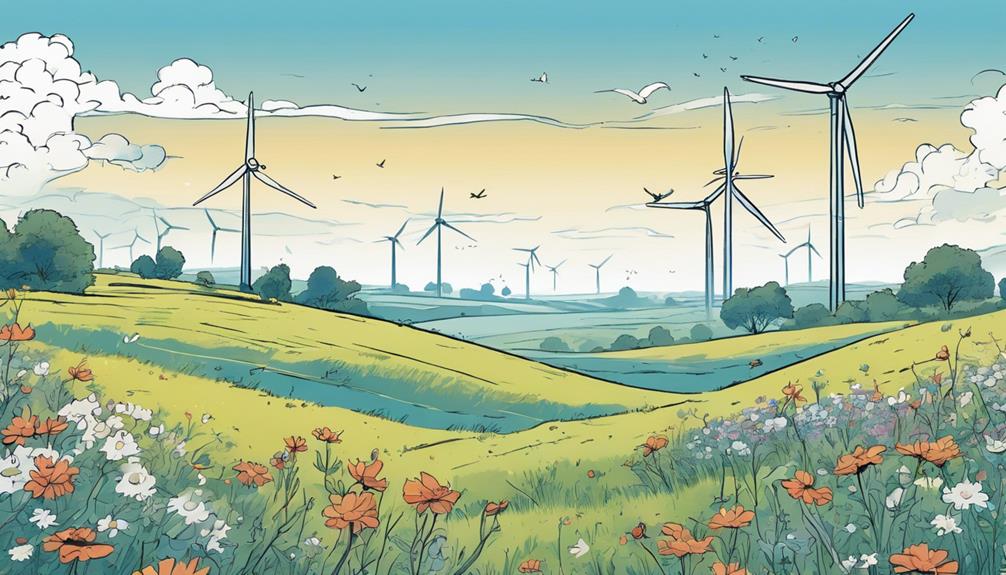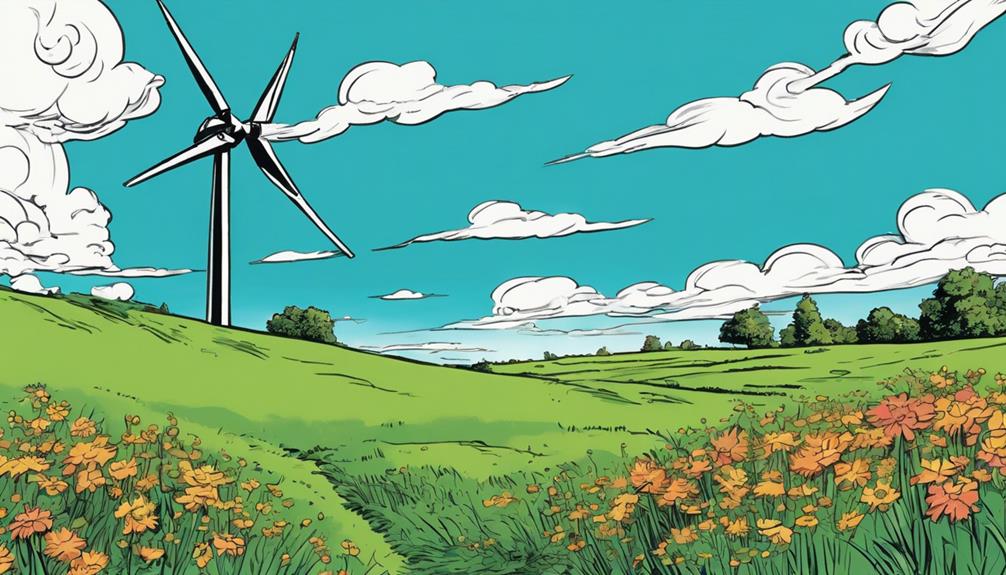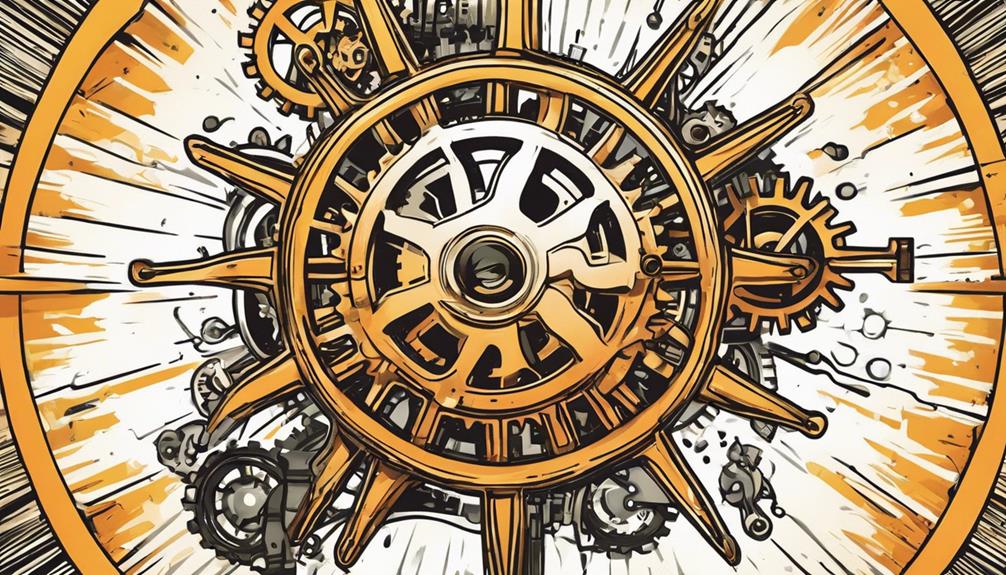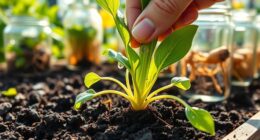As we harness the power of wind energy, we're not only reducing our reliance on fossil fuels and mitigating climate change, but also accessing a cleaner, more sustainable future for generations to come. Wind turbines convert moving air into mechanical power, and efficient design and best location are essential. By understanding the fundamentals, we can overcome integration challenges and successfully adopt wind energy. We'll explore the environmental impact, sustainability, and global implications of wind energy, and discover how countries like Denmark, the USA, and Germany are leading the way. Let's dive deeper into the world of wind energy and uncover its vast potential.
Key Takeaways
- Efficient turbine design and optimal location are crucial for harnessing wind energy, with wind speed directly impacting energy generation.
- Advanced materials and aerodynamic tweaks can enhance turbine efficiency, while turbulence and direction must be considered for optimal performance.
- Successful wind energy adoption requires overcoming integration challenges, such as variability and grid stability, through advanced grid management techniques.
- Wind energy offers numerous benefits, including reducing reliance on fossil fuels, mitigating climate change, and creating jobs, making it a vital component of a sustainable future.
- Proper environmental impact assessment and mitigation strategies are essential to ensure that wind energy adoption balances ecosystem balance and wildlife protection with its benefits.
Wind Energy Fundamentals

Harnessing wind energy begins with comprehending its fundamental principles. Wind turbines convert the kinetic energy of moving air into mechanical power, and ultimately, electricity.
We're not just discussing any old breeze, though – efficient turbine design and optimal location selection are pivotal for maximizing wind power production.
It's no surprise wind energy is the fastest-growing renewable energy source globally. The advantages are evident: it's clean, renewable, creates jobs, reduces greenhouse gas emissions, and has minimal environmental impact.
As we explore further into the world of wind energy, understanding these basics is vital to grasp the full potential of this sustainable solution. By doing so, we can unleash the true power of wind energy.
Turbine Efficiency Factors

How do we optimize wind turbines to squeeze every last watt out of the breeze?
We've got to take into account the factors that affect turbine efficiency. Wind speed is a no-brainer – the faster the wind, the more energy we can generate.
But direction and turbulence matter too. Turbulence can reduce efficiency by up to 20%, so we need to position our turbines carefully.
Advanced materials like carbon fiber composites can also enhance efficiency. And let's not forget aerodynamic tweaks, like optimizing blade shape and angle.
Overcoming Integration Challenges

With wind energy production varying widely depending on weather conditions, we're faced with the challenging task of guaranteeing a stable power supply to the grid. This variability poses a significant obstacle in integrating wind energy into the power grid, as it affects voltage and frequency stability.
To overcome this, we're developing advanced grid management techniques, such as smart grid technologies, to ensure a smooth integration of wind energy. Real-time monitoring and predictive analytics also play a vital role in anticipating and adapting to changes in wind energy production.
Successful Wind Energy Adoption

As we explore successful wind energy adoption, we can look to countries like Denmark, the USA, and Germany, which have made significant strides in integrating wind power into their energy mix.
These nations have demonstrated that wind energy can be a reliable and efficient source of electricity, reducing our reliance on fossil fuels and mitigating climate change.
In Denmark, wind power accounts for over 40% of the country's electricity generation, while in Texas, USA, wind farms have created thousands of jobs and generated billions of dollars in revenue.
Germany's Energiewende program has also seen significant success, with wind energy playing an essential role in the country's shift to renewable energy.
Environmental Impact Assessment

As we weigh the benefits of wind energy, we must also consider its environmental impact, acknowledging that while wind turbines have a relatively small footprint, their placement and operation can still impact local ecosystems and wildlife.
We must guarantee that wind farms are sited carefully to avoid sensitive habitats and minimize disruptions to natural environments. Proper evaluation and mitigation strategies are essential to reducing the risk of harm to wildlife, such as birds and bats, and preserving ecosystem balance.
Sustainability and Global Impact

By harnessing wind energy, we can greatly decrease our reliance on fossil fuels, alleviating climate change and propelling the global shift towards a more sustainable future.
As we shift to renewable energy sources, we're not only reducing greenhouse gas emissions but also fueling economic growth through job creation.
Wind energy's environmental benefits are undeniable, and its adoption is pivotal in mitigating climate change.
We're seeing countries like Denmark, the USA, and Germany leading the way in wind energy adoption, reducing carbon emissions, and creating jobs.
With favorable policies and significant investments, we can overcome the challenges and unleash the full potential of wind energy as a sustainable solution to our global energy needs.
Unlocking Wind Energy Potential

We're on the brink of a wind energy revolution, with cutting-edge technologies and innovative strategies poised to reveal the vast, untapped potential of this renewable resource.
As we push the boundaries of wind energy production, we're discovering new ways to harness the power of the wind. Advances in turbine design, materials, and installation techniques are allowing us to tap into previously inaccessible wind resources.
We're also developing more efficient ways to transmit and store wind energy, making it a more reliable and consistent source of power. By unveiling the full potential of wind energy, we can accelerate our shift to a low-carbon economy and create a more sustainable future for generations to come.
Frequently Asked Questions
Can Wind Energy Power Entire Cities Independently?
"We can envision a future where wind energy powers entire cities, but currently, it's not feasible independently, as variability in wind availability and lack of efficient storage systems hinder consistent power supply."
How Does Wind Turbine Noise Impact Nearby Residential Areas?
"As the blades whisper secrets to the wind, we acknowledge that turbine noise can be a nuisance, but with proper siting and sound-reducing designs, nearby residents can rest easy, enjoying the gentle hum of progress."
Are Wind Turbines a Viable Option for Personal Electricity Generation?
We're considering wind turbines for personal electricity generation, and while they can be a viable option, we need to assess our location's wind speed, turbine size, and local regulations to guarantee feasibility and efficiency.
Can Wind Energy Be Used for Water Purification and Desalination?
"We're bringing ancient wisdom to the modern era, just like our ancestors who harnessed wind to pump water. Yes, wind energy can power water purification and desalination systems, providing clean drinking water for communities worldwide."
What Is the Average Lifespan of a Wind Turbine Blade?
We're curious about the average lifespan of a wind turbine blade. Typically, it's around 20-25 years, depending on factors like wind speeds, maintenance, and quality of materials used in their construction.
What are the Techniques for Maximizing Wind Energy Output?
The techniques for maximizing wind turbine power output include optimizing the location of the turbines to capture the maximum wind energy, using advanced rotor designs to increase efficiency, and incorporating smart grid technology to better integrate the generated energy into the overall power system. These strategies can significantly increase the overall wind energy output.
Conclusion
As we stand at the threshold of a wind-powered future, we're poised to reveal the secrets of this renewable resource. We'll harness its potential to power our homes, fuel our economies, and preserve our planet.
With efficient turbines, prime locations, and innovative tech, we'll maximize production, reduce emissions, and create a sustainable tomorrow.
Together, we'll mitigate climate change, protect habitats, and forge a cleaner, greener world for generations to come.










